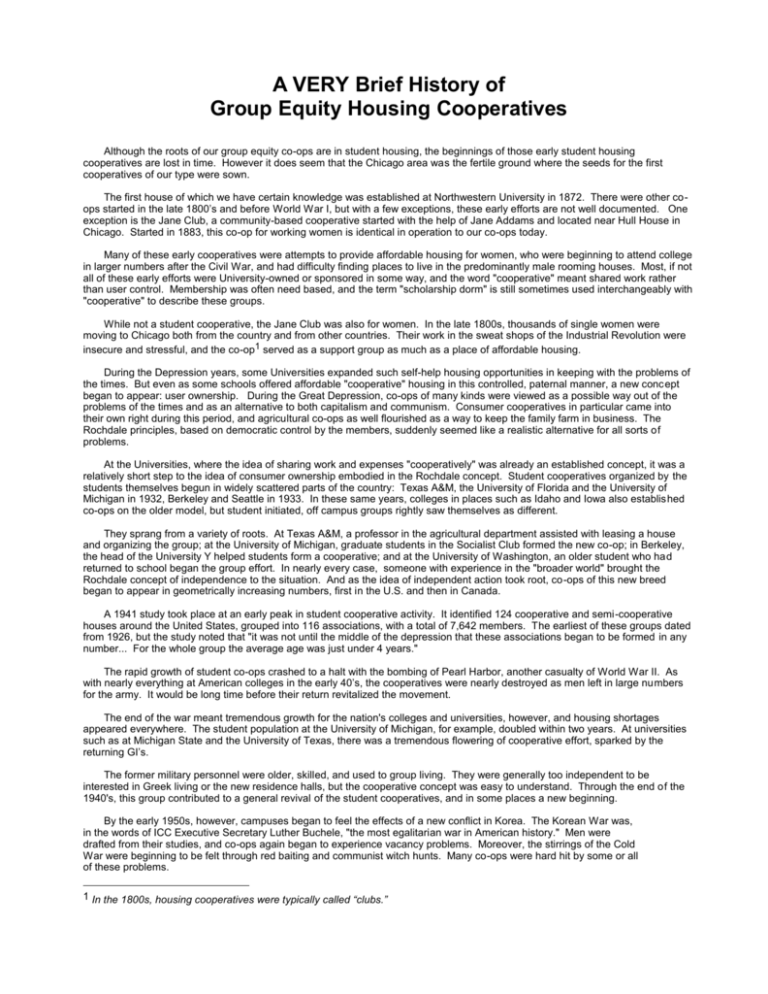National Stud. Coop Hist 2/94
advertisement

A VERY Brief History of Group Equity Housing Cooperatives Although the roots of our group equity co-ops are in student housing, the beginnings of those early student housing cooperatives are lost in time. However it does seem that the Chicago area was the fertile ground where the seeds for the first cooperatives of our type were sown. The first house of which we have certain knowledge was established at Northwestern University in 1872. There were other coops started in the late 1800’s and before World War I, but with a few exceptions, these early efforts are not well documented. One exception is the Jane Club, a community-based cooperative started with the help of Jane Addams and located near Hull House in Chicago. Started in 1883, this co-op for working women is identical in operation to our co-ops today. Many of these early cooperatives were attempts to provide affordable housing for women, who were beginning to attend college in larger numbers after the Civil War, and had difficulty finding places to live in the predominantly male rooming houses. Most, if not all of these early efforts were University-owned or sponsored in some way, and the word "cooperative" meant shared work rather than user control. Membership was often need based, and the term "scholarship dorm" is still sometimes used interchangeably with "cooperative" to describe these groups. While not a student cooperative, the Jane Club was also for women. In the late 1800s, thousands of single women were moving to Chicago both from the country and from other countries. Their work in the sweat shops of the Industrial Revolution were insecure and stressful, and the co-op1 served as a support group as much as a place of affordable housing. During the Depression years, some Universities expanded such self-help housing opportunities in keeping with the problems of the times. But even as some schools offered affordable "cooperative" housing in this controlled, paternal manner, a new concept began to appear: user ownership. During the Great Depression, co-ops of many kinds were viewed as a possible way out of the problems of the times and as an alternative to both capitalism and communism. Consumer cooperatives in particular came into their own right during this period, and agricultural co-ops as well flourished as a way to keep the family farm in business. The Rochdale principles, based on democratic control by the members, suddenly seemed like a realistic alternative for all sorts of problems. At the Universities, where the idea of sharing work and expenses "cooperatively" was already an established concept, it was a relatively short step to the idea of consumer ownership embodied in the Rochdale concept. Student cooperatives organized by the students themselves begun in widely scattered parts of the country: Texas A&M, the University of Florida and the University of Michigan in 1932, Berkeley and Seattle in 1933. In these same years, colleges in places such as Idaho and Iowa also established co-ops on the older model, but student initiated, off campus groups rightly saw themselves as different. They sprang from a variety of roots. At Texas A&M, a professor in the agricultural department assisted with leasing a house and organizing the group; at the University of Michigan, graduate students in the Socialist Club formed the new co-op; in Berkeley, the head of the University Y helped students form a cooperative; and at the University of Washington, an older student who had returned to school began the group effort. In nearly every case, someone with experience in the "broader world" brought the Rochdale concept of independence to the situation. And as the idea of independent action took root, co-ops of this new breed began to appear in geometrically increasing numbers, first in the U.S. and then in Canada. A 1941 study took place at an early peak in student cooperative activity. It identified 124 cooperative and semi-cooperative houses around the United States, grouped into 116 associations, with a total of 7,642 members. The earliest of these groups dated from 1926, but the study noted that "it was not until the middle of the depression that these associations began to be formed in any number... For the whole group the average age was just under 4 years." The rapid growth of student co-ops crashed to a halt with the bombing of Pearl Harbor, another casualty of World War II. As with nearly everything at American colleges in the early 40’s, the cooperatives were nearly destroyed as men left in large numbers for the army. It would be long time before their return revitalized the movement. The end of the war meant tremendous growth for the nation's colleges and universities, however, and housing shortages appeared everywhere. The student population at the University of Michigan, for example, doubled within two years. At universities such as at Michigan State and the University of Texas, there was a tremendous flowering of cooperative effort, sparked by the returning GI’s. The former military personnel were older, skilled, and used to group living. They were generally too independent to be interested in Greek living or the new residence halls, but the cooperative concept was easy to understand. Through the end of the 1940's, this group contributed to a general revival of the student cooperatives, and in some places a new beginning. By the early 1950s, however, campuses began to feel the effects of a new conflict in Korea. The Korean War was, in the words of ICC Executive Secretary Luther Buchele, "the most egalitarian war in American history." Men were drafted from their studies, and co-ops again began to experience vacancy problems. Moreover, the stirrings of the Cold War were beginning to be felt through red baiting and communist witch hunts. Many co-ops were hard hit by some or all of these problems. 1 In the 1800s, housing cooperatives were typically called “clubs.” However the 1950s also brought seeds that would later blossom into major growth for at least some student co-ops. In 1957, the North American Student Cooperative League (NASCL) and the Cooperative League of the USA (CLUSA) undertook to change the laws of the United States to make federal financing available for student housing cooperatives. After an incredible effort by all involved, President Eisenhower signed the housing bill of 1959, which included an amended College Housing Program. The legislation provided that student housing cooperatives for the first time would be eligible to receive low cost federal loans. There was a problem, however. The legislation also that the university co-sign on any loan, which most colleges and universities either were unwilling or legally unable to do. Finally, in the mid-1960s, this was changed to university approval of loans. Meanwhile, Canadian students in 1964 were able to secure an amendment to the National Housing Act to allow student co-ops to obtain long term, low interest financing for student co-op projects. More than $50 million in projects, many of them high rises coops with 500 to 900 members, were built between 1966 and 1974. Inspired by the Canadian experience, the Inter-Cooperative Council approached HUD with a proposal to construct a building on the University of Michigan's North Campus. Finished in 1970, this became the first major effort under the revised College Housing Program of HUD. Richard Nixon eventually canceled the College Housing Program, and after a number of spectacular failures, the Canadian program was ended as well. In the meantime, however, these governmental programs provided funding for a number of campus groups to begin or expand , particularly in Michigan, Minnesota, Ontario, California and Texas. This growth came at a perfect time, coinciding with the arrival of the Baby Boom generation. The housing shortages and radical world views of this group almost insured a market for cooperative housing regardless of the scale and pace of growth. The "counter-culture" that characterized this group emphasized control and independence from the "establishment." What more perfect vehicle for this philosophy than the co-ops? From the mid-1960s to the mid-1970s, interest in cooperative ideals resulted in the establishment of thousands of food cooperatives in university communities, as well as long waiting lists for housing co-ops. In 1987, a number of the larger student co-ops, working with the North American Students of Cooperation (NASCO) and the National Cooperative Business Association (NCBA) initiated a more organized approach to development. The Campus Cooperative Development Corporation (CCDC), as the development venture came to be known, helped local groups to establish cooperatives at schools where previously none had existed. In more recent years, the group was re-named NASCO Development Services. In 1988, NASCO Properties was organized as a national property holding company, and in 1989, the Kagawa Fund for Student Cooperative Development was started through a donation from the Japanese Consumer Cooperative Union. Together, these intercooperative efforts have resulted in the development of new cooperatives in a number of cities from California to Massachusetts. Expansion and development of new cooperatives continued in the 2000’s, and as the housing bubble burst, opportunities for purchasing at lower prices abounded, particularly in the older industrial heartland. NASCO Properties grew rapidly during these years, and some independent groups were also able to muster the resources needed to purchase property in such an environment. The National Cooperative Bank and the rise of a number of non-profit loan funds has been particularly important to this new development, as was NASCO Development Services, which brought a higher level of expertise to the table. Today our group equity cooperatives receive little assistance from college administrations or governmental funding sources, but they continue to expand where they are well established and attract interest and attention where they are not. Perhaps even more importantly, interest in cooperative housing is growing among both student and post-student groups. Our tenacious co-ops have developed a tradition of low cost, self-help operations, constant and effective member education, cooperation among cooperatives, and even cooperation between sectors and across boarders. It is likely that our cooperative associations will continue to prosper so long as our members share these cooperative values. Jim Jones 2012






